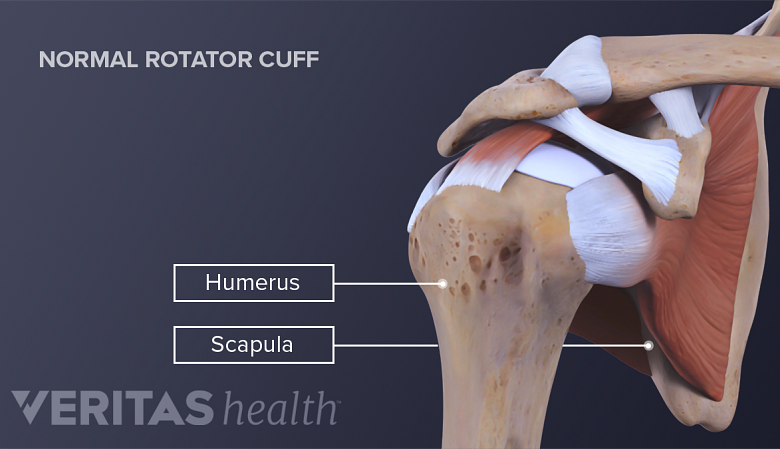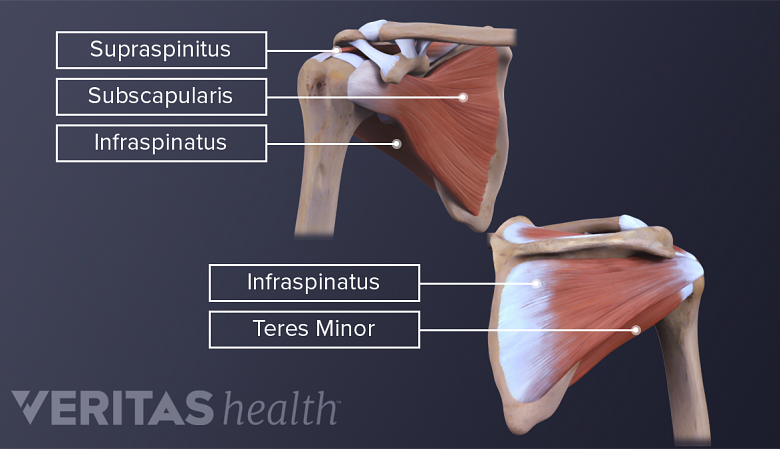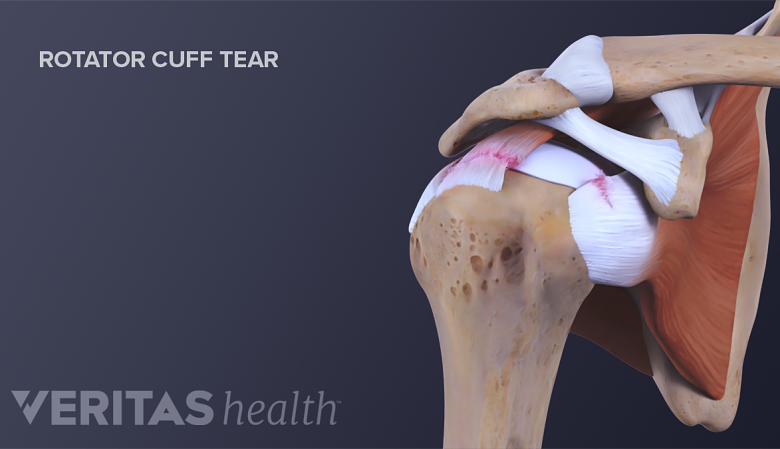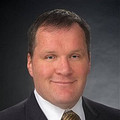An injured rotator cuff is diagnosed when muscles and tendons that support and surround the shoulder joint are torn. The defining symptoms include shoulder weakness and pain that flares with arm movement or when lying on the side of the affected shoulder.
The rotator cuff muscles and tendons create a “cuff” around the shoulder’s ball-and-socket joint.
Rotator cuff injury is the most common shoulder disorder and affects 20% to 40% of the general population.1Tashjian RZ. Epidemiology, natural history, and indications for treatment of rotator cuff tears. Clinics in Sports Medicine. 2012;31(4):589-604. Doi: https://doi.org/10.1016/j.csm.2012.07.001,2Vasudevan JM, Browne BJ. Hemiplegic shoulder pain. Physical Medicine and Rehabilitation Clinics of North America. 2014;25(2):411-437. Doi: https://doi.org/10.1016/j.pmr.2014.01.010
Here’s a detailed explanation of the causes, symptoms, and treatments of rotator cuff injuries.
In This Article:
What Is a Rotator Cuff Injury?
The rotator cuff is a sleeve made up of 4 muscles and their tendons that surround the shoulder joint and control its movements.
Essential points to know:
- A rotator cuff injury happens when one or more of the four muscles or tendons that form the cuff are damaged.
- Tendons are injured more commonly than muscles.
- It can affect one or both shoulders and may or may not cause symptoms.
- The injury reduces the rotator cuff’s ability to stabilize the shoulder’s movements, causing pain and weakness when the joint is moved or pressed.
- Shoulder problems such as shoulder impingement can lead to rotator cuff injuries over time.
Rotator cuff injuries are also called rotator cuff tears or rotator cuff disease.
How the Rotator Cuff Works
The rotator cuff muscles provide mobility and stability to the shoulder.
The four muscles of the rotator cuff provide the ball-and-socket shoulder joint with mobility and stability. These muscles begin, or originate, at the scapula (shoulder blade) and converge at the greater tuberosity of the humerus (upper arm bone).
The four rotator cuff muscles are:
- Subscapularis, at the front of the shoulder
- Supraspinatus, at the top of the shoulder
- Infraspinatus, at the back of the shoulder
- Teres minor, also located at the back of the shoulder, below the infraspinatus
When working properly, these muscles and their tendons:
- Propel the shoulder to move smoothly throughout its nearly 180 degrees of mobility
- Stabilize the shoulder’s ball-and-socket joint by hugging the relatively large humeral head (ball) to the comparatively small glenoid bone (socket)
An injury to the rotator cuff affects the shoulder joint’s stability and range of movement.
2 Ways the Rotator Cuff Gets Injured
Both acute and chronic injuries can cause tearing of the rotator cuff muscles.
Injury to the muscle or tendon occurs in one of 2 ways:
- Acute injuries: Overstretching or tearing of muscles or tendons that results from a one-time traumatic event, such as holding out the arm to break a fall or an acute sports injury (eg, horseback riding, hockey, and soccer)
- Chronic degeneration: Occurs due to overuse (fatigue) or entrapment (impingement) of the rotator cuff, causing the tissue to degenerate and become weak and painful. Chronic degeneration also significantly increases the risk of an acute tear.
Athletes who use one shoulder repetitively, such as baseball pitchers or tennis players, and people in occupations who use one shoulder repetitively, like construction workers, are especially prone to chronic rotator cuff injuries.
In general, acute injuries occur in younger individuals, and chronic injuries are seen in older people.
What Happens During a Rotator Cuff Injury?
Here are 2 things that can happen to the muscle or tendon:
- Inflammation: The tissue gets pulled or overstretched and becomes inflamed, causing mild to moderate pain and stiffness during joint movements.
- Tears: The tissue partially or completely tears, creating a break in its body or separating it from the bone, often resulting in moderate to severe pain and weakness.
Rotator cuff tears are further classified into:
- High-grade tear: involves more than 50% thickness of the muscle or tendon
- Low-grade tear: involves less than 50% thickness of the muscle or tendon
- Full tear: complete severing of the soft tissue
- Partial tear: some of the tissue is still intact. Partial tears of the rotator cuff are further classified based on severity:
- Grade 1 tear: less than 3 mm long
- Grade 2 tear: 3 mm to 6 mm long
- Grade 3 tear: more than 6 mm long
How Long Does a Rotator Cuff Injury Take to Heal?
The duration of a rotator cuff injury varies widely depending on several factors:
- Severity of the injury: Inflammation and minor tears heal within a few weeks with rest and self-care. Larger tears require months of non-surgical treatments or even surgery.
- Treatment: Prompt and appropriate treatment speeds up recovery.
- Nicotine use: Any form of nicotine use, including smoking, vaping, and chewing tobacco, slows down rotator cuff healing.
Delaying treatment or ignoring the symptoms makes a rotator cuff injury worse.
Shoulder Pain that Mimics Rotator Cuff Injury
Shoulder muscle and tendon pain shares a common set of symptoms with several other shoulder conditions:
- SLAP tear (superior labrum anterior to posterior)
- Shoulder impingement
- Shoulder osteoarthritis
- Biceps tendinitis
- Cervical radiculopathy
It is possible for these problems to coexist with rotator cuff tears.
When to See a Doctor for Shoulder Pain
It is recommended to have any concerning symptoms promptly evaluated by a healthcare professional.
Certain shoulder symptoms indicate a serious medical problem, such as infection or tumor in the shoulder, neck, or upper back. These symptoms include but are not limited to:
- Severe pain that progressively worsens and interferes with daily activities or work
- Night pain that causes disturbed sleep
- Unexplained weight loss without trying to lose weight
- Pain radiating beyond the shoulder into the arm down the arm
- A persistent or high fever accompanying the shoulder pain
- Excessive sweating during sleep
- Lumps or masses in the shoulder or neck area.
- Unusual redness or swelling in the shoulder joint
- Loss of strength or feeling in the arm or hand
Shoulder pain that starts after trauma also warrants prompt medical evaluation.
Rotator cuff injury is diagnosed and treated by physical medicine specialists, such as physiatrists, sports medicine specialists, physical therapists, chiropractors, and orthopedic surgeons.
- 1 Tashjian RZ. Epidemiology, natural history, and indications for treatment of rotator cuff tears. Clinics in Sports Medicine. 2012;31(4):589-604. Doi: https://doi.org/10.1016/j.csm.2012.07.001
- 2 Vasudevan JM, Browne BJ. Hemiplegic shoulder pain. Physical Medicine and Rehabilitation Clinics of North America. 2014;25(2):411-437. Doi: https://doi.org/10.1016/j.pmr.2014.01.010







